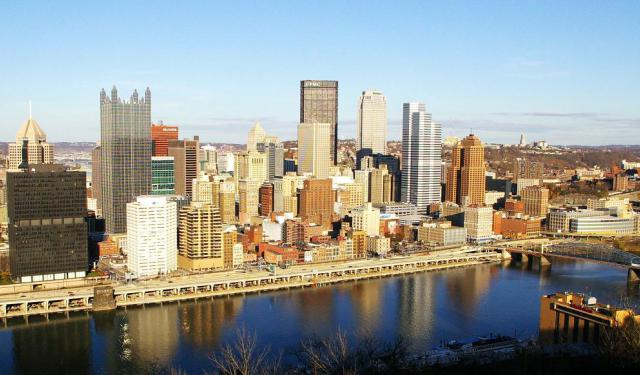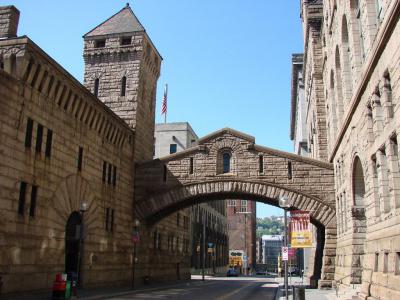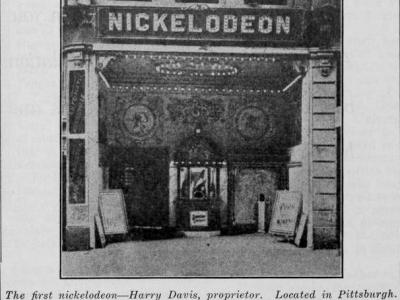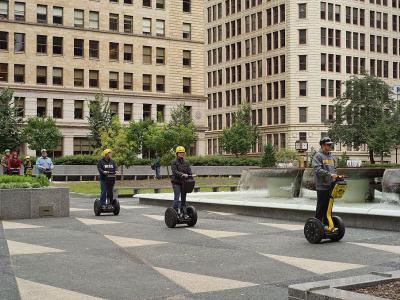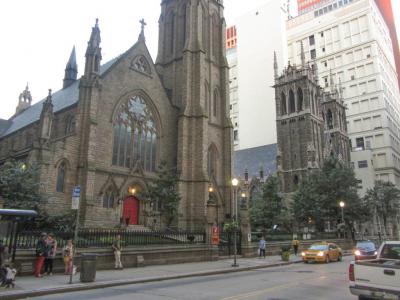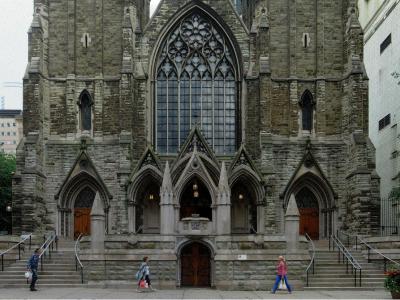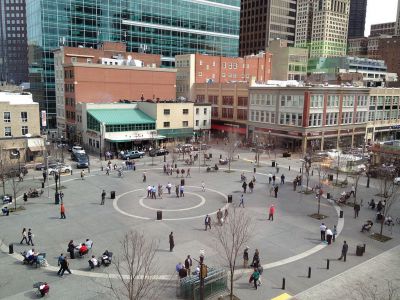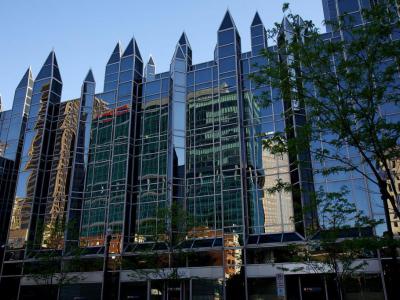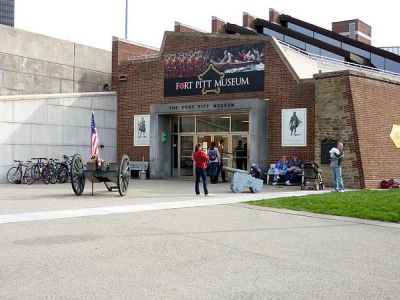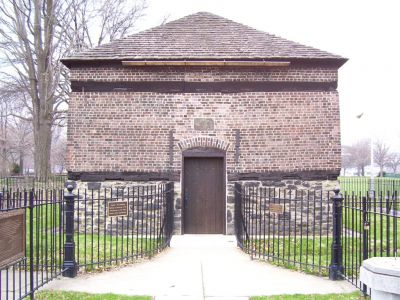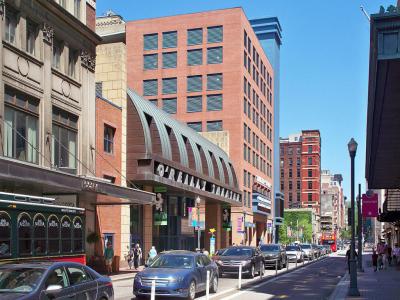Pittsburgh Introduction Walking Tour (Self Guided), Pittsburgh
Pittsburgh is the second largest city in Pennsylvania. The metro area is also the largest in Appalachia, the Ohio Valley and one of the most populous in the country. It known colloquially as "Steel City" due to its mainstay as a leader in manufacturing steel and other important materials like glass and aluminum. Pittsburgh also holds an important place in the history of the United States.
The city was incorporated in 1794, though it had been established long before that time. Native Americas, particularly the Shawnee, had inhabited the area long before the first European settlers arrived in 1669. Nearly 100 years later, after the French and Indian War, the settlement was given the name Pittsburgh in honor of William Pitt.
Over the years, Pittsburgh became well known for manufacturing. It was the home of Andrew Carnegie's Carnegie Steel Company, later US Steel, and Heinz, which is now the Kraft Heinz Company. The large influx of manufacturing brought with it investments in the culture and architecture of the region. The city was home to the world's first nickelodeon theatre, the world's first commercial radio station and the first public radio station in the U.S. The city was also home to the polio vaccine and the invention of the internet emoticon.
Visitors to the city can now see such places as Heinz Hall for the Performing Arts, the site of the world's first nickelodeon theatre, Fort Pitt Blockhouse in the Point State Park and other interesting attractions. This self guided walking tour takes you to see the most important historical and cultural sights in the downtown Pittsburgh. Grab a bottle of water and explore!
The city was incorporated in 1794, though it had been established long before that time. Native Americas, particularly the Shawnee, had inhabited the area long before the first European settlers arrived in 1669. Nearly 100 years later, after the French and Indian War, the settlement was given the name Pittsburgh in honor of William Pitt.
Over the years, Pittsburgh became well known for manufacturing. It was the home of Andrew Carnegie's Carnegie Steel Company, later US Steel, and Heinz, which is now the Kraft Heinz Company. The large influx of manufacturing brought with it investments in the culture and architecture of the region. The city was home to the world's first nickelodeon theatre, the world's first commercial radio station and the first public radio station in the U.S. The city was also home to the polio vaccine and the invention of the internet emoticon.
Visitors to the city can now see such places as Heinz Hall for the Performing Arts, the site of the world's first nickelodeon theatre, Fort Pitt Blockhouse in the Point State Park and other interesting attractions. This self guided walking tour takes you to see the most important historical and cultural sights in the downtown Pittsburgh. Grab a bottle of water and explore!
How it works: Download the app "GPSmyCity: Walks in 1K+ Cities" from Apple App Store or Google Play Store to your mobile phone or tablet. The app turns your mobile device into a personal tour guide and its built-in GPS navigation functions guide you from one tour stop to next. The app works offline, so no data plan is needed when traveling abroad.
Pittsburgh Introduction Walking Tour Map
Guide Name: Pittsburgh Introduction Walking Tour
Guide Location: USA » Pittsburgh (See other walking tours in Pittsburgh)
Guide Type: Self-guided Walking Tour (Sightseeing)
# of Attractions: 10
Tour Duration: 2 Hour(s)
Travel Distance: 3.2 Km or 2 Miles
Author: DanaOffice
Sight(s) Featured in This Guide:
Guide Location: USA » Pittsburgh (See other walking tours in Pittsburgh)
Guide Type: Self-guided Walking Tour (Sightseeing)
# of Attractions: 10
Tour Duration: 2 Hour(s)
Travel Distance: 3.2 Km or 2 Miles
Author: DanaOffice
Sight(s) Featured in This Guide:
- Old Allegheny County Jail
- Nickelodeon (America's First Commercial Movie Theater)
- Mellon Square
- Trinity Episcopal Cathedral
- First Presbyterian Church of Pittsburgh
- Market Square
- PPG Place
- Fort Pitt Museum
- Fort Pitt Blockhouse
- Cultural District
1) Old Allegheny County Jail
The old Allegheny County Jail, built between 1884 and 1886, was in continual use for over 100 years. Among the most notable former prisoners was Alexander Berkman, who was held at the county jail while awaiting trial. Jack and Ed Biddle were notorious prisoners who escaped with the help of the warden's wife who had developed a relationship with the brothers.
In 1972, the jail was added to the list of Pittsburgh historic designations. It was named as a National Historic Landmark in 1976. In the late 1990s, the Allegheny County Jail was converted into a family courthouse, which is a purpose it continues to serve to this day.
The jail was built by the Norcross Brothers and designed by architect H.H. Richardson in the Romanesque Revival style. Visitors can enjoy the beauty of the building's exterior, but they are welcome indoors as well. The interior is open for tours and contains the Old Allegheny County Jail Museum. A self-guided tour is available. Docents are also on-hand to answer any questions.
Visitors should be aware that the interior is only open on Mondays. Likewise, as it is a working courthouse, tourists must pass through a metal detector. No photography is allowed inside.
In 1972, the jail was added to the list of Pittsburgh historic designations. It was named as a National Historic Landmark in 1976. In the late 1990s, the Allegheny County Jail was converted into a family courthouse, which is a purpose it continues to serve to this day.
The jail was built by the Norcross Brothers and designed by architect H.H. Richardson in the Romanesque Revival style. Visitors can enjoy the beauty of the building's exterior, but they are welcome indoors as well. The interior is open for tours and contains the Old Allegheny County Jail Museum. A self-guided tour is available. Docents are also on-hand to answer any questions.
Visitors should be aware that the interior is only open on Mondays. Likewise, as it is a working courthouse, tourists must pass through a metal detector. No photography is allowed inside.
2) Nickelodeon (America's First Commercial Movie Theater) (must see)
The very first moving picture theater in the United States, called Nickelodeon, opened on June 19, 1905 in a small storefront on Smithfield Street in Pittsburgh. Developed by John Harris and Harry Davis, the venue had 96 seats and only charged five cents, or one nickel, per show that lasted 15 minutes. The name Nickelodeon is a combination of two words: "nickel" (the cost of admission) and "odeon" (the Greek word for "theatre").
Prior to that, moving pictures had been projected on store fronts, in warehouses and other locations throughout the world, but Harris and Davis's Nickelodeon was the first structure fully designated to this purpose.
The new entertainment facility proved to be a hit and attracted 450 customers on day one, followed by another 1,500 the next day. The entrepreneurs soon expanded the theater to 200 seats, seeing around 7,000 people visiting every day between 8 am and midnight at its peak. In fact, the theater was so successful that soon nickelodeons sprang up all over the country, reaching over 8,000 nationwide by 1908.
Back in early 1900s, Pittsburgh was the epicenter of the film world. Ironically the first Nickelodeon was short-lived due to its own success. It was demolished only five years after the original opening in favor of the newer, larger, purpose-built cinema that could accommodate bigger audiences for longer feature films. Even though the first Nickelodeon no longer exists, its impact can still be felt by moviegoers. It was this genius invention by John Harris and Harry Davis that led to the creation of the motion picture theatre industry that we know today.
To commemorate the historic event on June 19, 1905, a plaque in honor of the first Nickelodeon theater has been placed at its former location on Smithfield Street. "This was the beginning of the motion picture theater industry", it says.
Why You Should Visit:
If you are regular moviegoer, a visit to the birthplace of commercial movie theater in the world is a most-do in Pittsburgh.
Prior to that, moving pictures had been projected on store fronts, in warehouses and other locations throughout the world, but Harris and Davis's Nickelodeon was the first structure fully designated to this purpose.
The new entertainment facility proved to be a hit and attracted 450 customers on day one, followed by another 1,500 the next day. The entrepreneurs soon expanded the theater to 200 seats, seeing around 7,000 people visiting every day between 8 am and midnight at its peak. In fact, the theater was so successful that soon nickelodeons sprang up all over the country, reaching over 8,000 nationwide by 1908.
Back in early 1900s, Pittsburgh was the epicenter of the film world. Ironically the first Nickelodeon was short-lived due to its own success. It was demolished only five years after the original opening in favor of the newer, larger, purpose-built cinema that could accommodate bigger audiences for longer feature films. Even though the first Nickelodeon no longer exists, its impact can still be felt by moviegoers. It was this genius invention by John Harris and Harry Davis that led to the creation of the motion picture theatre industry that we know today.
To commemorate the historic event on June 19, 1905, a plaque in honor of the first Nickelodeon theater has been placed at its former location on Smithfield Street. "This was the beginning of the motion picture theater industry", it says.
Why You Should Visit:
If you are regular moviegoer, a visit to the birthplace of commercial movie theater in the world is a most-do in Pittsburgh.
3) Mellon Square
Mellon Square is an outdoor, public garden in downtown Pittsburgh. It is unique in that it is built on top of a parking structure. Originally constructed in 1955, the 1.37 acre garden is the first of its kind.
Mellon Square was endowed by and named after the Mellon family. The influential family provided a total of $8 million to purchase and develop the land. That sum would be the equivalent of over $80 million today.
Along with green space that consists of over 25,000 trees, flowers and shrubs, Mellon Square includes a cascading fountain, a nightly water show and an elevated terrace. The park has a stage is regularly used for performances and speaking events as well.
Self-guided walking tours of Pittsburgh can easily incorporate Mellon Square due to its central location and easy accessibility. Admirers of architecture will appreciate that it is located directly adjacent to the Omni William Penn Hotel and offers a stunning view of the First Presbyterian Church of Pittsburgh.
Mellon Square was endowed by and named after the Mellon family. The influential family provided a total of $8 million to purchase and develop the land. That sum would be the equivalent of over $80 million today.
Along with green space that consists of over 25,000 trees, flowers and shrubs, Mellon Square includes a cascading fountain, a nightly water show and an elevated terrace. The park has a stage is regularly used for performances and speaking events as well.
Self-guided walking tours of Pittsburgh can easily incorporate Mellon Square due to its central location and easy accessibility. Admirers of architecture will appreciate that it is located directly adjacent to the Omni William Penn Hotel and offers a stunning view of the First Presbyterian Church of Pittsburgh.
4) Trinity Episcopal Cathedral
Trinity Cathedral serves as the main cathedral for the Episcopal Diocese of Pittsburgh. The current Gothic-style church, which is the third building to accommodate the congregation, was finished in 1872 on the location of an old hilltop cemetery. This spot, situated on a terrace overlooking the historic "point" where the Allegheny River and the Monongahela River meet to form the Ohio River, held significance for Native Americans as a burial site. Early settlers also utilized it as a cemetery, and the congregation erected its second church there in 1824.
Trinity Churchyard contains the oldest marked graves west of the Atlantic Seaboard, including those of Native American leaders, French, English, and American colonists. The initial Trinity Church was constructed two blocks to the west of this burial ground at the foot of the hill or terrace during the late 18th and early 19th centuries.
In 1824, Trinity relocated to its present location in the middle of the churchyard on the terrace, featuring what is considered the first Gothic-style structure in Western Pennsylvania. John Henry Hopkins oversaw the design and building of the cathedral, which included buttresses, a tower, pointed arches, and a vaulted ceiling. The new Trinity Cathedral was completed in 1872, standing as the tallest building in the city until the construction of the Allegheny County Courthouse in 1888.
Trinity Churchyard contains the oldest marked graves west of the Atlantic Seaboard, including those of Native American leaders, French, English, and American colonists. The initial Trinity Church was constructed two blocks to the west of this burial ground at the foot of the hill or terrace during the late 18th and early 19th centuries.
In 1824, Trinity relocated to its present location in the middle of the churchyard on the terrace, featuring what is considered the first Gothic-style structure in Western Pennsylvania. John Henry Hopkins oversaw the design and building of the cathedral, which included buttresses, a tower, pointed arches, and a vaulted ceiling. The new Trinity Cathedral was completed in 1872, standing as the tallest building in the city until the construction of the Allegheny County Courthouse in 1888.
5) First Presbyterian Church of Pittsburgh
The First Presbyterian Church is nestled among the high rises of downtown Pittsburgh. The Neo-Gothic designed church was built in 1905 by Theophilus P. Chandler Jr. It has 253 stained glass windows, 13 of which were painted by hand by Tiffany Studios. The church has a wooden ceiling and a pipe organ with 4,400 individual pipes in a Baroque-style casing.
Visitors are welcome to the church service on Sundays where they can worship while also admiring the interior architecture. Those who prefer to view the church's exterior still have plenty to admire.
Along with the building's facade, tourists can step next door to view the historic cemetery, which is located between the First Presbyterian Church and Trinity Episcopal Cathedral. The Trinity Burying Ground is the oldest cemetery in Pittsburgh. Some of the graves date to the 1800s, including that of congressperson James S. Stevenson.
Visitors are welcome to the church service on Sundays where they can worship while also admiring the interior architecture. Those who prefer to view the church's exterior still have plenty to admire.
Along with the building's facade, tourists can step next door to view the historic cemetery, which is located between the First Presbyterian Church and Trinity Episcopal Cathedral. The Trinity Burying Ground is the oldest cemetery in Pittsburgh. Some of the graves date to the 1800s, including that of congressperson James S. Stevenson.
6) Market Square
Market Square is a good spot for shopping, dining and entertainment. It is arguably the perfect spot for those on walking tours to take a break and relax in the midst of a busy day of tourism. It's also a prime spot for people watching or picking up some much-needed mementos from a trip to the Steel City.
The history of Market Square dates to the late 18th century. It was originally seen as a public commons in 1764 when it was known as Diamond Square. By the 1790's this area housed the first courthouse, first jail and first newspaper.
The historic buildings of Market Square still stand tall. However, they are now filled with retail spaces, food service, hotels and a theatre. Market Square has plenty of entertainment to offer to tourists of all ages. Games like ping pong and giant Jenga are offered during daytime hours. KidsPlay offers fun and educational opportunities for children. Lucky tourists might even stumble upon dancing, yoga or a public art exhibit.
The history of Market Square dates to the late 18th century. It was originally seen as a public commons in 1764 when it was known as Diamond Square. By the 1790's this area housed the first courthouse, first jail and first newspaper.
The historic buildings of Market Square still stand tall. However, they are now filled with retail spaces, food service, hotels and a theatre. Market Square has plenty of entertainment to offer to tourists of all ages. Games like ping pong and giant Jenga are offered during daytime hours. KidsPlay offers fun and educational opportunities for children. Lucky tourists might even stumble upon dancing, yoga or a public art exhibit.
7) PPG Place (must see)
Architects Philip Johnson and John Burgee designed PPG Place in 1981. The Pittsburgh Plate Glass Company, as it was originally known, spans more than five acres and three city blocks. It is an outstanding architectural marvel that is easily recognized by its highly reflective surface and more than 200 glass spires.
PPG Place is made up of six buildings of varying sizes and heights. The tallest is One PPG Place. Standing at 40 stories, it is the third highest in Pittsburgh. The second tallest of the buildings is Six PPG Place, which is 14 stories tall. The other four buildings each stand at six floors.
One PPG Place is not just the tallest but also the most well known. A popular portion of One PPG Place is the Wintergarden, which is attached at the ground level. This event space has vaulted glass ceilings that allow the indoor garden to remain fresh and green throughout the year. Visitors can walk through the Wintergarden or stop to enjoy a cup of coffee.
Along with the buildings is PPG Plaza. This outdoor space includes a 140 jet fountain that has sprays that reach up to 15 feet in height. The fountain operates from 6 AM to 10 PM daily from March through October. In the winter months the plaza is converted into a 6,000 square foot skating rink.
Why You Should Visit:
- To see the "Crown Jewel of the Pittsburgh Skyline"
- To admire the glass spires that top the buildings
- To enjoy special events like carriage rides and art exhibits
Tips:
PPG Place is a working office complex. As such, the bulk of the beauty lies in the building's facade. Enjoy walking around the buildings and through the plaza, but don't worry about spending time inside.
PPG Place is made up of six buildings of varying sizes and heights. The tallest is One PPG Place. Standing at 40 stories, it is the third highest in Pittsburgh. The second tallest of the buildings is Six PPG Place, which is 14 stories tall. The other four buildings each stand at six floors.
One PPG Place is not just the tallest but also the most well known. A popular portion of One PPG Place is the Wintergarden, which is attached at the ground level. This event space has vaulted glass ceilings that allow the indoor garden to remain fresh and green throughout the year. Visitors can walk through the Wintergarden or stop to enjoy a cup of coffee.
Along with the buildings is PPG Plaza. This outdoor space includes a 140 jet fountain that has sprays that reach up to 15 feet in height. The fountain operates from 6 AM to 10 PM daily from March through October. In the winter months the plaza is converted into a 6,000 square foot skating rink.
Why You Should Visit:
- To see the "Crown Jewel of the Pittsburgh Skyline"
- To admire the glass spires that top the buildings
- To enjoy special events like carriage rides and art exhibits
Tips:
PPG Place is a working office complex. As such, the bulk of the beauty lies in the building's facade. Enjoy walking around the buildings and through the plaza, but don't worry about spending time inside.
8) Fort Pitt Museum
Point State Park is filled with numerous sites and activities that can't be found in any other U.S. city. One of the outstanding sites is Fort Pitt Museum. This indoor/outdoor museum is located in a recreated Fort Pitt. It details the fort's important roles during the American Revolution and the Whiskey Rebellion.
Visitors to the museum will see numerous artifacts from the early days of Pennsylvania and the city of Pittsburgh. They will take a trip into a history with a recreation of 18th century frontier life. The tour includes a trader's cabin, soldier's barracks and a replica casemate.
Tourists can also take part in some hands-on activities at the Fort Pitt Museum. They are welcome to practice tomahawk throwing, take a guided tour or watch a living history exhibit. The Royal American Regiment will display how to properly fire a musket. Food is prepared outdoors over an open fire. Visitors will even see wood chopping and sewing demonstrations outdoors.
Visitors to the museum will see numerous artifacts from the early days of Pennsylvania and the city of Pittsburgh. They will take a trip into a history with a recreation of 18th century frontier life. The tour includes a trader's cabin, soldier's barracks and a replica casemate.
Tourists can also take part in some hands-on activities at the Fort Pitt Museum. They are welcome to practice tomahawk throwing, take a guided tour or watch a living history exhibit. The Royal American Regiment will display how to properly fire a musket. Food is prepared outdoors over an open fire. Visitors will even see wood chopping and sewing demonstrations outdoors.
9) Fort Pitt Blockhouse (must see)
The blockhouse is the only structure left of Fort Pitt, making it the oldest structure in this part of the state. The fort was built in 1764 by the British as a defense against Native American attacks. Later, it was used as a trading post, and then as housing.
After Henry Bouquet stopped the siege at Fort Pitt he ordered the construction of a number of supporting structures around the periphery. The blockhouse is all that remains of his defensive structure. This is thanks to the fact the blockhouse was the only building that remained in use as a house when the fort was demolished in 1792.
Visitors can go to Point State Park to view the Fort Pitt Blockhouse at any time while during the park's open hours. They can view the interior and exterior of the blockhouse to see the full structure of the building.
Outside of the blockhouse is the Edith Ammon Memorial Garden. The landscaping was created to honor the memory of Edith Ammon, who was instrumental in preserving the blockhouse. Indeed, Ammon helped the Pittsburgh chapter of the Daughter's of the Revolution gain ownership of the Fort Pitt Blockhouse. They then restored it and opened it to the public in 1894.
Point State Park is located at the confluence of the Ohio and Monongahela Rivers. Tourists to the park can walk along the Three Rivers Heritage Trail, which will lead them to the Fort Pitt blockhouse as well as the accompanying museum. They can also take the time to visit Fort Duquesne and the Point State Park Fountain.
Why You Should Visit:
To see an important piece of American Revolutionary history
To view the building techniques of simple structures from the late 18th century
Tips:
There is no cost to visit the Fort Pitt blockhouse. It is open during daylight hours on weekends throughout the year. From April through October, the fort is open on Wednesdays and Thursdays as well.
After Henry Bouquet stopped the siege at Fort Pitt he ordered the construction of a number of supporting structures around the periphery. The blockhouse is all that remains of his defensive structure. This is thanks to the fact the blockhouse was the only building that remained in use as a house when the fort was demolished in 1792.
Visitors can go to Point State Park to view the Fort Pitt Blockhouse at any time while during the park's open hours. They can view the interior and exterior of the blockhouse to see the full structure of the building.
Outside of the blockhouse is the Edith Ammon Memorial Garden. The landscaping was created to honor the memory of Edith Ammon, who was instrumental in preserving the blockhouse. Indeed, Ammon helped the Pittsburgh chapter of the Daughter's of the Revolution gain ownership of the Fort Pitt Blockhouse. They then restored it and opened it to the public in 1894.
Point State Park is located at the confluence of the Ohio and Monongahela Rivers. Tourists to the park can walk along the Three Rivers Heritage Trail, which will lead them to the Fort Pitt blockhouse as well as the accompanying museum. They can also take the time to visit Fort Duquesne and the Point State Park Fountain.
Why You Should Visit:
To see an important piece of American Revolutionary history
To view the building techniques of simple structures from the late 18th century
Tips:
There is no cost to visit the Fort Pitt blockhouse. It is open during daylight hours on weekends throughout the year. From April through October, the fort is open on Wednesdays and Thursdays as well.
10) Cultural District
Downtown Pittsburgh's Cultural District is a 14 square block area that includes theaters, art galleries, restaurants and shopping. There are also a number of important landmarks scattered through the Cultural District that should not be missed by any visitors to Pittsburgh.
Self-guided walking tours of Pittsburgh's Cultural District might start with a walk along the Allegheny Riverfront Park. From there, tourists can walk through the District to see such historic structures as the 1903 Byham Theater, 1928's Benedum Center, the August Wilson Center for African American Culture and Heinz Hall.
Visitors may wish to stop to take in a show at one of the many concert halls and theaters. They can also see the Pittsburgh Ballet, the Pittsburgh Civic Light Opera and the Pittsburgh Symphony Orchestra. There are also a number of open spaces for performances and art exhibitions.
Self-guided walking tours of Pittsburgh's Cultural District might start with a walk along the Allegheny Riverfront Park. From there, tourists can walk through the District to see such historic structures as the 1903 Byham Theater, 1928's Benedum Center, the August Wilson Center for African American Culture and Heinz Hall.
Visitors may wish to stop to take in a show at one of the many concert halls and theaters. They can also see the Pittsburgh Ballet, the Pittsburgh Civic Light Opera and the Pittsburgh Symphony Orchestra. There are also a number of open spaces for performances and art exhibitions.
Walking Tours in Pittsburgh, Pennsylvania
Create Your Own Walk in Pittsburgh
Creating your own self-guided walk in Pittsburgh is easy and fun. Choose the city attractions that you want to see and a walk route map will be created just for you. You can even set your hotel as the start point of the walk.
Pittsburgh's Historical Churches
Pittsburgh's storied landscape is interwoven with the resplendent charm of its historical churches. Apart from being testaments to the city's rich religious heritage and the enduring spirit of faith, these abodes of worship stand as venerable monuments, whose architectural splendor etched an indelible mark on Pittsburgh.
Foremost among them is the First Presbyterian Church. This... view more
Tour Duration: 1 Hour(s)
Travel Distance: 1.4 Km or 0.9 Miles
Foremost among them is the First Presbyterian Church. This... view more
Tour Duration: 1 Hour(s)
Travel Distance: 1.4 Km or 0.9 Miles
Mount Washington Walking Tour
Mount Washington is a hill on the southern banks of the Monongahela River and Ohio River. Due to its elevated position, the top of the hill offers a spectacular view of Downtown Pittsburgh below. The Mount is a prime tourist attraction in the city, and many photos and drawings of the Pittsburgh skyline have originated here.
If you want to see what Pittsburgh looks like from above, take this... view more
Tour Duration: 1 Hour(s)
Travel Distance: 1.8 Km or 1.1 Miles
If you want to see what Pittsburgh looks like from above, take this... view more
Tour Duration: 1 Hour(s)
Travel Distance: 1.8 Km or 1.1 Miles
Oakland District Walking Tour
Welcome to Oakland, an academic and cultural center of Pittsburgh! Representing a harmonious blend of intellectual prowess, cultural marvels, and natural splendor, this captivating neighborhood brims with attractions to overlook which would be a terrible miss!
As a manifestation of the transformative power of knowledge and creativity, Oakland, in large part, owes its status to the 19th-century... view more
Tour Duration: 2 Hour(s)
Travel Distance: 2.8 Km or 1.7 Miles
As a manifestation of the transformative power of knowledge and creativity, Oakland, in large part, owes its status to the 19th-century... view more
Tour Duration: 2 Hour(s)
Travel Distance: 2.8 Km or 1.7 Miles
Downtown Architectural Jewels
Pittsburgh's Downtown is laden with an array of stylish architectural gems. Scattered throughout the city's urban core, these landmarks, some of which date back as far as the 18th century, collectively evoke an air of grandeur and historical significance.
The Fort Pitt Blockhouse, an emblem of resilience and frontier spirit, is the oldest extant structure in Western Pennsylvania,... view more
Tour Duration: 2 Hour(s)
Travel Distance: 2.6 Km or 1.6 Miles
The Fort Pitt Blockhouse, an emblem of resilience and frontier spirit, is the oldest extant structure in Western Pennsylvania,... view more
Tour Duration: 2 Hour(s)
Travel Distance: 2.6 Km or 1.6 Miles
The Most Popular Cities
/ view all
